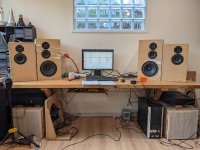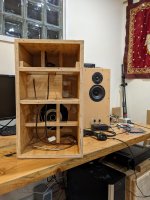Hello,
I am building a speaker similar the to the Troels Gravesen SBAcoustics 3-Way Classic, using the same drivers. 8" woofer, 4" mid, 1" tweeter. These will be active speakers (no passive crossover).
http://www.troelsgravesen.dk/SBAcoustics-3WC.htm
These will be placed on a desk for use as monitors, similar to this photo:

Question is about the arrangement of the drivers. Either all three vertically aligned, or the mid and tweeter vertically aligned with the woofer on the side - a lot of 3-way professional studio monitors are designed like this. For example:
https://en-de.neumann.com/kh-310-a
Vertical 3-way
Pro - looks more like a conventional speaker, and can be used in other settings eg living room
Con - tweeter and mid are higher than ear height (when seated)
Horizontal 3-way
Pro - can put a riser underneath to adjust the height of the mid and tweeter to ear height
Pro - drivers closer together (more like a point source), which is better for a close listening distance.
Con - drivers are not in a line vertically
Con - narrower sweet spot due to horizontal dispersion different to vertical arrangement?

Any thoughts on this?
I am building a speaker similar the to the Troels Gravesen SBAcoustics 3-Way Classic, using the same drivers. 8" woofer, 4" mid, 1" tweeter. These will be active speakers (no passive crossover).
http://www.troelsgravesen.dk/SBAcoustics-3WC.htm
These will be placed on a desk for use as monitors, similar to this photo:
Question is about the arrangement of the drivers. Either all three vertically aligned, or the mid and tweeter vertically aligned with the woofer on the side - a lot of 3-way professional studio monitors are designed like this. For example:
https://en-de.neumann.com/kh-310-a
Vertical 3-way
Pro - looks more like a conventional speaker, and can be used in other settings eg living room
Con - tweeter and mid are higher than ear height (when seated)
Horizontal 3-way
Pro - can put a riser underneath to adjust the height of the mid and tweeter to ear height
Pro - drivers closer together (more like a point source), which is better for a close listening distance.
Con - drivers are not in a line vertically
Con - narrower sweet spot due to horizontal dispersion different to vertical arrangement?
Any thoughts on this?
I think the main benefit of woofer on the side is having the option to adjust the soundstage width swapping the boxes around, i.e. tweeters together or tweeters apart. As far as point source considerations are concerned the horizontal plane is typically more important, especially if the workspace is wide, so having the drivers in a vertical line is likely an improvement for nearfield monitoring IMHO.
Well, getting the mids/tweet at ear level is most important to me, so mirror image TM to the outside of the woofers to help with time delay for me.
Since the final mix prepared using a studio monitor is intended for the typical speaker arrangement (of the end listener), the vertical arrangement is more suitable for a studio monitor, as the speakers used by most listeners are made that way. Just my opinion.
You will have more free desk area vith all-vertical layout. Horizontal speakers are typically mounted on a shelf above the desk. Then a vertical speaker can be put upside down.
Horizontal layout with vertical mid+tweeter works just fine acoustically, because wavelength of WM xo is long, xo 2-300Hz. A dome mid might have a problem even then, because it is typically crossed at 6-800Hz
Some high class 3-way monitors have a separate faceplate for MT, which can be rotated! Same speaker works left or right or vertica!.

Horizontal layout with vertical mid+tweeter works just fine acoustically, because wavelength of WM xo is long, xo 2-300Hz. A dome mid might have a problem even then, because it is typically crossed at 6-800Hz
Some high class 3-way monitors have a separate faceplate for MT, which can be rotated! Same speaker works left or right or vertica!.
Crossover from woofer to mid is at 550Hz. Half a wavelength at 550Hz is ~31cm, quarter wavelength at ~15cm. Assuming the spacing between W and M is about 30cm, then when you're 30degrees off axis there will be a -3dB dip around 550Hz and at 90degrees off axis total cancellation.
If it's important that when you move around your desk/room a hole doesn't appear in the mids then the vertical arrangement will do you better.
If it's important that when you're up standing close to the speaker or sitting on the floor a hole doesn't appear in the mids then the horizontal arrangement will do you better.
The off axis response between mid and tweeter will be even worse, so avoid any arrangement where you can't get mid/tweeter at ear height.
If it's important that when you move around your desk/room a hole doesn't appear in the mids then the vertical arrangement will do you better.
If it's important that when you're up standing close to the speaker or sitting on the floor a hole doesn't appear in the mids then the horizontal arrangement will do you better.
The off axis response between mid and tweeter will be even worse, so avoid any arrangement where you can't get mid/tweeter at ear height.
Makes sense. Based on that, vertical arrangement will be the way to go.I think the main benefit of woofer on the side is having the option to adjust the soundstage width swapping the boxes around, i.e. tweeters together or tweeters apart. As far as point source considerations are concerned the horizontal plane is typically more important, especially if the workspace is wide, so having the drivers in a vertical line is likely an improvement for nearfield monitoring IMHO.
That's a good idea. Rotatable plate so the speaker can be set up as left, right or vertical.You will have more free desk area vith all-vertical layout. Horizontal speakers are typically mounted on a shelf above the desk. Then a vertical speaker can be put upside down.
Horizontal layout with vertical mid+tweeter works just fine acoustically, because wavelength of WM xo is long, xo 2-300Hz. A dome mid might have a problem even then, because it is typically crossed at 6-800Hz
Some high class 3-way monitors have a separate faceplate for MT, which can be rotated! Same speaker works left or right or vertica!.
View attachment 1010571
With my current setup I tried moving the chair up and down 20cm and didn't notice any change in the sound, but when I stood up it sounded quite different. But will mostly be listening sitting down. I think vertical is the way to go for this build.Crossover from woofer to mid is at 550Hz. Half a wavelength at 550Hz is ~31cm, quarter wavelength at ~15cm. Assuming the spacing between W and M is about 30cm, then when you're 30degrees off axis there will be a -3dB dip around 550Hz and at 90degrees off axis total cancellation.
If it's important that when you move around your desk/room a hole doesn't appear in the mids then the vertical arrangement will do you better.
If it's important that when you're up standing close to the speaker or sitting on the floor a hole doesn't appear in the mids then the horizontal arrangement will do you better.
The off axis response between mid and tweeter will be even worse, so avoid any arrangement where you can't get mid/tweeter at ear height.
I'd make the desk less wide (in fact, try to minimise it) and create an acoustically superior setup for your monitors. Don't get it that people put all their money in good monitors and seem to deny that the sound from any speaker on a desktop will be compromised by the reflected sound from that same desk.
Optimal mid field placement in the traditional triangular listening arrangement is always best with drivers oriented vertically, allowing for mixing with a wide soundstage and creating a more natural stereo image. Mixing near field with monitors on top of the desk is not conducive to a natural stereo image and it creates many other issues which are difficult to compensate for. With most speakers, the drivers wont integrate well listening that close unless the monitors are specifically designed to be used near field like a big pair of headphones. A larger 3 way monitor just won't work well in the near field for many reasons, unless you absolutely need the SPL in the low end.
So this is what I ended up building (not quite finished). The 2-way speakers I built previously are shown for comparison. Overall I would say it has been a success - they sound noticeably better than the 2-way speakers. More articulate bass and better mids (which is what I wanted). Studio monitor is a bit of a misnomer - they will be used for general listening most of the time.
Attachments
- Home
- Loudspeakers
- Multi-Way
- 3-way speaker used as studio monitor - vertical or horizontal arrangement of drivers?

